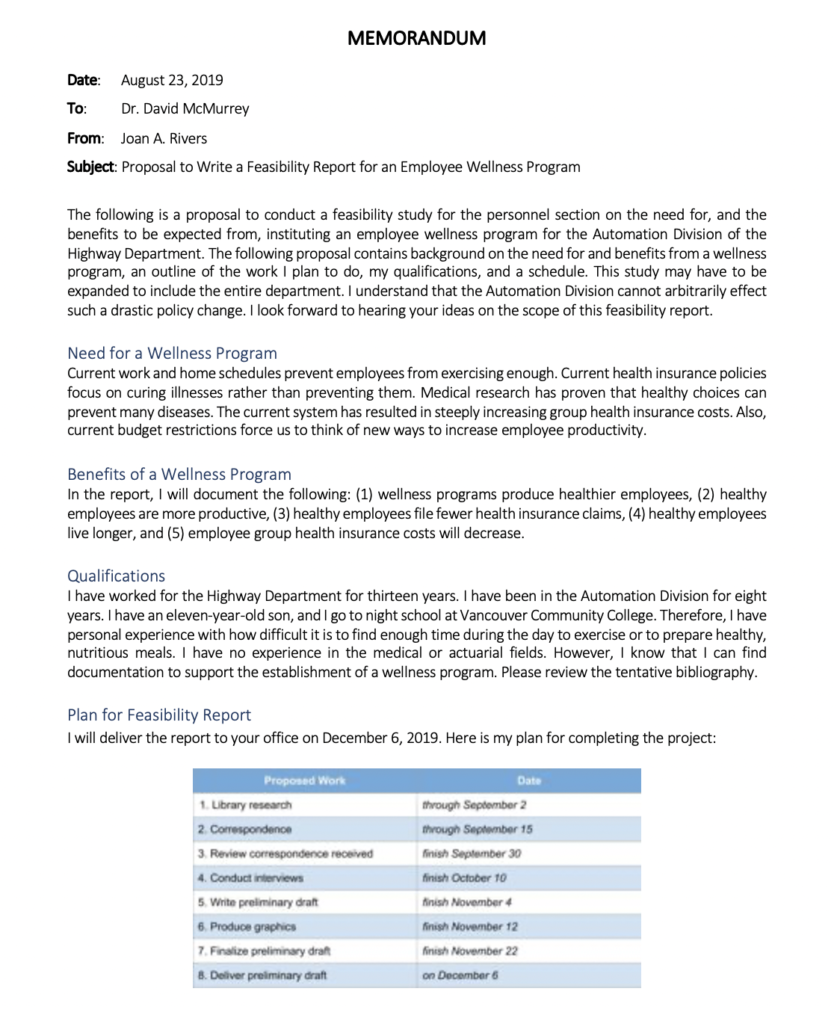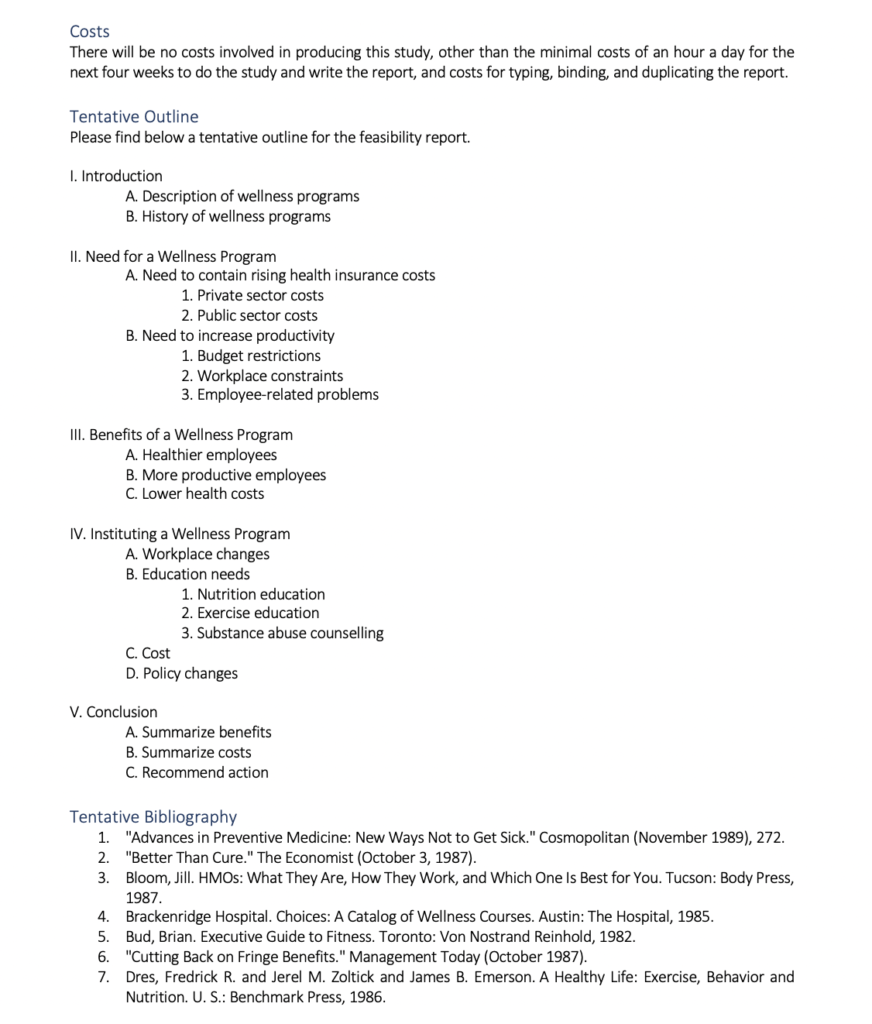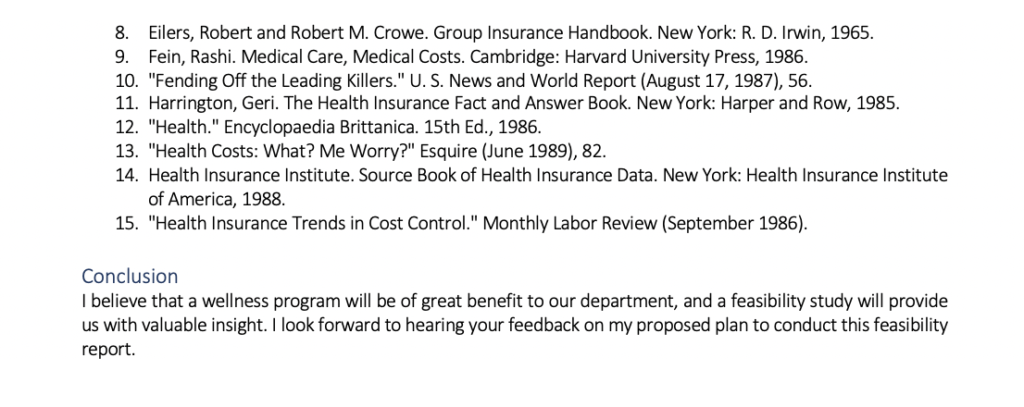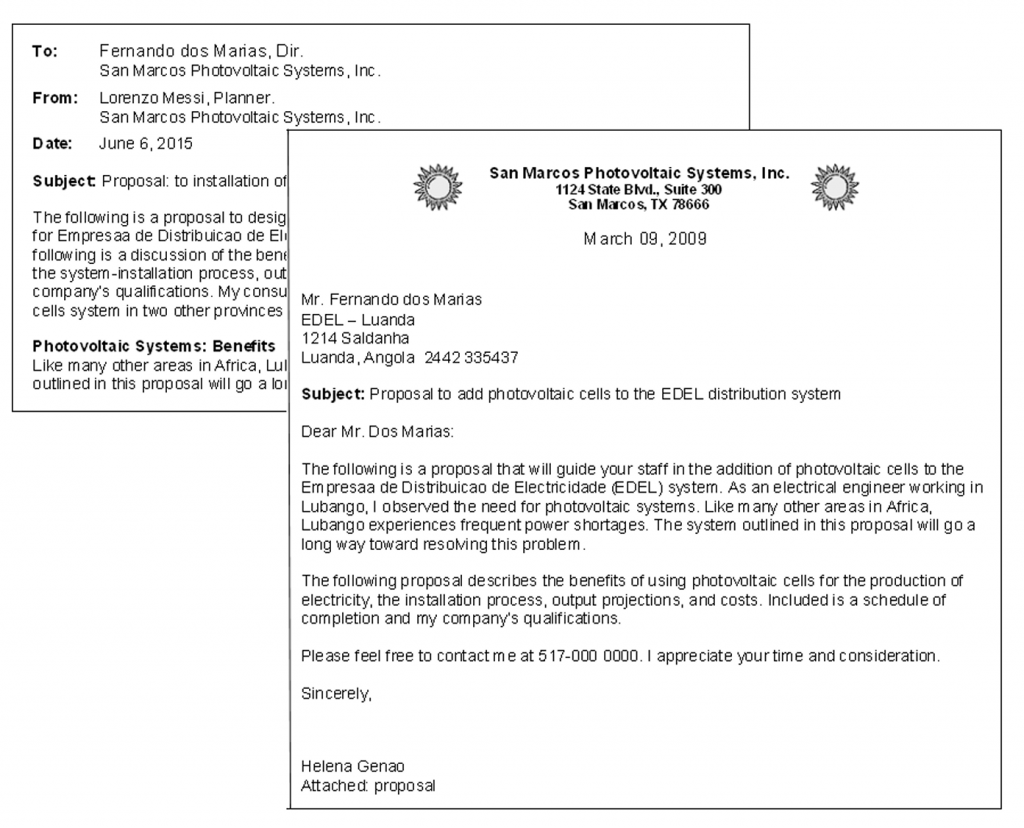Chapter 13: Business Proposals
Venecia Williams
Learning Objectives
- Describe the basic elements of a business proposal
- Discuss the main goals of a business proposal
- Identify effective strategies to use in a business proposal
Business proposals are documents designed to make a persuasive appeal to the audience to achieve a defined outcome, often proposing a solution to a problem. Much like a report, with several common elements and persuasive speech, a business proposal makes the case for your product or service. In order to be successful in business and industry, you should be familiar with the business proposal.
Let’s say you work in a health care setting. What types of products or services might be put out to bid? If your organization is going to expand and needs to construct a new wing, it will probably be put out to bid. Everything from office furniture to bedpans could potentially be put out to bid, specifying a quantity, quality, and time of delivery required. Janitorial services may also be bid on each year, as well as food services, and even maintenance. Using the power of bidding to lower contract costs for goods and services is common practice.
Effective business proposals are built around a great idea or solution. While you may be able to present your normal product, service, or solution in an interesting way, you want your document and its solution to stand out against the background of competing proposals. What makes your idea different or unique? How can you better meet the needs of the company than other vendors? What makes you so special? With the competitive nature of business proposals, your aim is to make your proposal stand out and ultimately win the contract.
Planning a Proposal
To begin planning a proposal, remember the basic definition: a proposal is an offer or bid to do a certain project for someone. Proposals may contain other elements—technical background, recommendations, results of surveys, information about feasibility, and so on. But the difference with a proposal is that it asks the audience to approve, fund, or grant permission to do the proposed project. If you plan to be a consultant or run your own business, written proposals may be one of your most important tools for bringing in business. And, if you work for a government agency, nonprofit organization, or a large corporation, the proposal can be a valuable tool for initiating projects that benefit the organization or you the employee/proposer (and usually both).
A proposal should contain information that would enable the audience of that proposal to decide whether to approve the project, to approve or hire you to do the work or both. To write a successful proposal, put yourself in the place of your audience and think about what sorts of information that person would need to feel confident having you do the project.
It’s easy to get confused about proposals. Imagine that you have a terrific idea for installing some new technology where you work and you write up a document explaining how it works and why it’s so great, showing the benefits, and then end by urging management to go for it. Is that a proposal? No, at least not in this context. It’s more like a feasibility report, which studies the merits of a project and then recommends for or against it. Now, all it would take to make this document a proposal would be to add elements that ask management for approval for you to go ahead with the project. Certainly, some proposals must sell the projects they offer to do, but in all cases, proposals must sell the writer (or the writer’s organization) as the one to do the project.
Persuasion- Ethos, Pathos, and Logos
Proposals are built on the three elements of persuasion: ethos, pathos and logos. A proposal’s ethos refers to credibility, pathos to passion and enthusiasm, and logos to logic or reason. All three elements are integral parts of your business proposal that require your attention. Who are you and why should they do business with you? Your credibility may be unknown to the potential client and it is your job to reference previous clients, demonstrate order fulfillment, and clearly show that your product or service is offered by a credible organization. By association, if your organization is credible the product or service is often thought to be more credible.
In the same way, if you are not enthusiastic about the product or service, why should the potential client get excited? How does your solution stand out in the marketplace? Why should they consider you? Why should they continue reading? Passion and enthusiasm are not only communicated through “!” exclamation points. Your thorough understanding, and your demonstration of that understanding, communicates dedication and interest.
Each assertion requires substantiation, each point clear support. It is not enough to make baseless claims about your product or service; you have to show why the claims you make are true, relevant, and support your central assertion that your product or service is right for this client. Make sure you have sources to support your points. Be detailed and specific.
Types of Proposals
Consider the situations in which proposals occur. A company may send out a public announcement requesting proposals for a specific project. This public announcement—called a request for proposals (RFP)—could be issued through newspapers, trade journals, Chamber of Commerce channels, or individual letters. Firms or individuals interested in the project would then write proposals in which they summarize their qualifications, project schedules and costs, and discuss their approach to the project. The recipient of all these proposals would then evaluate them, select the best candidate, and then prepare a contract.
But proposals come about much less formally. Imagine that you are interested in doing a project at work (for example, investigating the merits of bringing in some new technology to increase productivity). Imagine that you visited with your supervisor and tried to convince her of this. She might respond by saying, “Write me a proposal and I’ll present it to upper management.” As you can see from these examples, proposals can be divided into several categories:
- Solicited or unsolicited. Proposals are solicited or unsolicited. A solicited proposal is one in which the recipient has requested the proposal. Typically, a company will send out requests for proposals (RFPs) through the mail or publish them in some news source. But proposals can be solicited on a very local level: for example, you could be explaining to your boss how great it would be to install a new technology in the office; your boss might get interested and ask you to write up a proposal to do a formal study of the idea. Unsolicited proposals are those in which the recipient has not requested proposals. With unsolicited proposals, you sometimes must convince the recipient that a problem or need exists before you can begin the main part of the proposal.
- Internal or external. Proposals can be internal or external. A proposal to someone within your organization (a business, a government agency, etc.) is an internal proposal. With internal proposals, you may not have to include certain sections (such as qualifications) or as much information in them. An external proposal is one written from one separate, independent organization or individual to another such entity. The typical example is the independent consultant proposing to do a project for another firm.
- Informal or formal. Another type of proposal is informal or formal. An informal proposal is a short document, only a few pages long, normally in the format of a memo or letter and includes fewer sections than a formal proposal. Informal proposals generally include six sections: introduction, background, plan, staffing, budget and authorization (Guffey et al., 2019). Formal proposals are longer, more complex documents, and in addition to the six sections from the informal report, they include many of the other sections found in a typical report: a letter of transmittal, title page, table of contents, list of figures, executive summary, and additional information in the appendices. They may also include a copy of the RFR.
Common Sections in Proposals
You can be creative in many aspects of the business proposal but follow the traditional categories. Businesses expect to see information in a specific order, much like a résumé or even a letter. Each aspect of your proposal has its place and it is to your advantage to respect that tradition and use the categories effectively to highlight your product or service. Every category is an opportunity to sell and should reinforce your credibility, your passion, and the reason your solution is simply the best. Keep in mind that the sections included in your proposal are based on the type of proposal and the audience’s needs. Figure 13.1 highlights some of the common sections found in a proposal. Figure 13.1 provides an example of a proposal.



Copy of RFP
Include a copy of the RFP you are responding to when submitting a proposal. A company undertaking a major project may send out different RFPs for different parts of the project, so it is best to include the RFP to identify which issue you are planning to address.
Letter of Transmittal
As with a formal report, include a letter of transmittal which should briefly identify the issue you are aiming to solve and the benefits of your proposed plan.
Executive Summary
The executive summary provides a summary of the proposal and highlights the main aspects of the proposal. If some information seems repetitive, remember that business reports are not always read in the order written.
Title Page
Write a title that clearly and accurately describes your proposal. Include the name of the organization the proposal is for, the RPF number and the date. The title page should also have the name of the author(s) and the author’s organization.
Table of Contents
The table of contents enables the reader to quickly find the desired sections in your report. Format this page the way you would format the table of contents in a formal report.
List of Figures and Tables
Include a list of figures and tables if your report contains numerous illustrations, diagrams and charts.
Introduction
Plan the introduction to your proposal carefully. Make sure it does the following things (but not necessarily in this order) that apply to your particular proposal:
- Indicate that the document to follow is a proposal.
- Refer to some previous contact with the recipient of the proposal or to your source of information about the project.
- Find one brief motivating statement that will encourage the recipient to read on and to consider doing the project (if it’s an unsolicited or competitive proposal) and to give you the contract to do the project.
- Give an overview of the contents of the proposal.
Background on the Problem, Opportunity, or Situation
Often occurring just after the introduction, the background section discusses what has brought about the need for the project—what problem, what opportunity there is for improving things, what the basic situation is. It’s true that the audience of the proposal may know the problem very well, in which case this section might not be needed. Writing the background section still might be useful, however, in demonstrating your particular view of the problem. And, if the proposal is unsolicited, a background section is almost a requirement as you will need to convince the audience that the problem or opportunity exists and that it should be addressed.
Benefits and Feasibility of the Proposed Project
Most proposals discuss the advantages or benefits of doing the proposed project. This acts as an argument in favour of approving the project. Also, some proposals discuss the likelihood of the project’s success. In the unsolicited proposal, this section is particularly important as you are trying to “sell” the audience on the project.
When writing the plan, you want to explain how you’ll go about doing the proposed work. This acts as an additional persuasive element; it shows the audience you have a sound, well-thought-out approach to the project. Also, it serves as the other form of background some proposals need. Remember that the background section (the one discussed above) focuses on the problem or need that brings about the proposal. However, in this section, you discuss the background relating to the procedures or technology you plan to use in the proposed work. Once again, this gives you the proposal writer a chance to show that you know what you are talking about and to build confidence in the audience. Give enough information in your plan to secure the contract, but don’t include all the specifics (Guffey et al., 2019).
Schedule
Most proposals contain a section that shows not only the projected completion date but also key milestones for the project. If you are doing a large project spreading over many months, the timeline would also show dates on which you would deliver progress reports. And if you can’t cite specific dates, cite amounts of time for each phase of the project.
Qualifications
Most proposals contain a summary of the proposing individual’s or organization’s qualifications to do the proposed work. It’s like a mini-resume contained in the proposal. The proposal audience uses it to decide whether you are suited for the project. Therefore, this section lists work experience, similar projects, references, training, and education that shows familiarity with the project.
Budget and Resources
Most proposals also contain a section detailing the costs of the project, whether internal or external. With external projects, you may need to list your hourly rates, projected hours, costs of equipment and supplies, and so forth, and then calculate the total cost of the complete project. Internal projects of course are not free, but you should still list the project costs: for example, you can list hours you will need to complete the project, equipment and supplies you’ll be using, and assistance from other people in the organization.
Conclusions
The final paragraph or section of the proposal should bring readers back to a focus on the positive aspects of the project. In the final section, you can end by urging them to get in touch to work out the details of the project, to remind them of the benefits of doing the project, and reiterate the reasons your organization is the right choice for the project.
Special project-specific sections
Remember that the preceding sections are typical or common in written proposals, not absolute requirements. Think about the following questions:
- What else might your audience need to understand the nature and scope of the project?
- What else might your audience need to understand the benefits arising from the project?
- What other information might your readers need to be convinced to allow you to do the project?
- What else do they need to see in order to approve the project?
Format of Proposals
A professional document is a base requirement. If it is less than professional, you can count on its prompt dismissal. There should be no errors in spelling or grammar, and all information should be concise, accurate, and clearly referenced when appropriate. Information that pertains to credibility should be easy to find and clearly relevant, including contact information. If the document exists in a hard copy form, it should be printed on a letterhead. If the document is submitted in an electronic form, it should be in a file format that presents your document as you intended. Word processing files may have their formatting changed or adjusted based on factors you cannot control—like screen size—and information can shift out of place, making it difficult to understand. In this case, a portable document format (PDF)—a format for electronic documents—may be used to preserve content location and avoid any inadvertent format changes when it is displayed.
Effective persuasive proposals are often brief, even limited to one page. “The one-page proposal has been one of the keys to my business success, and it can be invaluable to you too. Few decision-makers can ever afford to read more than one page when deciding if they are interested in a deal or not. This is even more true for people of a different culture or language,” said Adnan Khashoggi, a successful multi-billionaire (Riley, 2002). Clear and concise proposals serve the audience well and limit the range of information to prevent confusion.
You have the following options for the format and packaging of your proposal. It does not matter which you use as long as you use the memorandum format for internal proposals and the business-letter format for external proposals.
-
- Cover letter or memo with separate proposal: In this format, you write a brief “cover” letter or memo and attach the proposal proper after it. The cover letter or memo briefly announces that a proposal follows and outlines the contents of it. In fact, the contents of the cover letter or memo are pretty much the same as the introduction (discussed in the previous section). Notice, however, that the introduction to the proposal proper that follows the cover letter or memo repeats much of what preceded. This is because the letter or memo may get detached from the proposal or the recipient may not even bother to look at the letter or memo and just dive right into the proposal itself.
- Consolidated business-letter or memo proposal: In this format, you consolidate the entire proposal with a standard business letter or memo. You include headings and other special formatting elements as if it were a report. This consolidated memo format is illustrated in the left portion of Figure 13.2.

Figure 13.2 | Consolidated vs Letter Memo
Revision Checklist for Proposals
As you reread and revise your proposal, watch out for problems such as the following:
- Make sure you use the right format. Remember, the memo format is for internal proposals; the business-letter format is for proposals written from one external organization to another.
- Write a good introduction.
- Make sure to identify exactly what you are proposing to do.
- Make sure that a report—a written document—is somehow involved in the project you are proposing to do.
- Make sure the sections are in a logical, natural order. For example, don’t present the audience with schedules and costs before you’ve gotten them interested in the project.
- Break out the costs section into specifics; include hourly rates and other such details. Don’t just include the final cost.
- For internal projects, don’t omit the section on costs and qualifications: there will be costs, just not direct ones. For example, how much time will you need, will there be printing, binding costs? Include your qualifications if you think your proposal will go to somebody in the organization who doesn’t know you.
- Watch out for generating technobabble. Yes, some of your proposal readers may know the technical side of your project—but others may not. Challenge yourself to bring difficult technical concepts down to a level that non-specialists can understand.
- Proofread and revise for grammar, mechanics and style.
Summary
An effective business proposal informs and persuades efficiently. It features many of the common elements of a report, but its emphasis on persuasion guides the overall presentation. Writing effective business proposals is a skill every business writer needs. Plan your proposal well and only include the sections necessary to both inform and persuade your audience. Remember that though you are offering a solution to a problem, your main intention is to sell your service.
End of Chapter Activities
13a. Thinking About the Content
What are your key takeaways from this chapter? What is something you have learned or something you would like to add from your experience?
13b. Discussion Questions
Discussion Questions
- Have you ever written a proposal? If yes, what were the sections you included?
- Search for an RFP (request for proposal) or similar call to bid, and post it to your class. Compare the results with your classmates, focusing on what is required to apply or bid.
- Identify a product or service you would like to produce or offer. List three companies that you would like to sell your product or service to and learn more about them. Post your findings, making the link between your product or service and company needs. You may find the Web site on creating a business plan (https://www.scu.edu/mobi/business-courses/starting-a-business/session-2-the-business-plan/#3) useful when completing this exercise.
13c. Applying chapter concepts to a situation
Proposing a new software
Nate was recently hired at the Green Grocers Supermarket as a part-time cashier. He only does the evening shifts as he has classes in the day time and wants to avoid having any conflicts in his schedule. A part of his daily duties includes balancing the cash register drawer at the end of his shift. When his colleagues do the evening shift, they have to complete this task as well.
The owner of the supermarket is concerned as she notices that the cashiers are struggling to balance the drawer some evenings. She tries to resolve this issue as inaccurate information is affecting the reliability of the record-keeping process.
Nate is aware of a free software that the cashiers can use to complete their cash register balancing task. This software can save time, eliminate human error and store worksheets digitally instead of having the team file hard copies each day. He shares this idea with his boss who tells him to submit it as a written proposal instead.
Write an executive summary outlining what Nate’s proposal to his boss will include.
13d. Writing Activity
Watch this video from TED.com on Dance vs. PowerPoint, a modest proposal. Summarize the video. What do you think of this idea of using dance instead of a “boring” PowerPoint? Would it work in a business setting, why or why not?
Attribution
This chapter contains information from Business Communication for Success which is adapted from a work produced and distributed under a Creative Commons license (CC BY-NC-SA) in 2010 by a publisher who has requested that they and the original author not receive attribution. This adapted edition is produced by the University of Minnesota Libraries Publishing through the eLearning Support Initiative, Business Communication For Everyone (c) 2019 by Arley Cruthers and is licensed under a Creative Commons-Attribution-NonCommercial-ShareAlike 4.0 International license, and Online Technical Writing by David McMurrey and is licensed under a Creative Commons Attribution 4.0 International License.
References
Guffey, M. E., Loewy, D., & Almonte, R. (2019). Essentials of Business Communication, Eighth Edition. Toronto, ON: Nelson Education /Cengage Learning.
Riley, P. G. (2002). The one-page proposal: How to get your business pitch onto one persuasive page (p. 2). New York, NY: HarperCollins.

